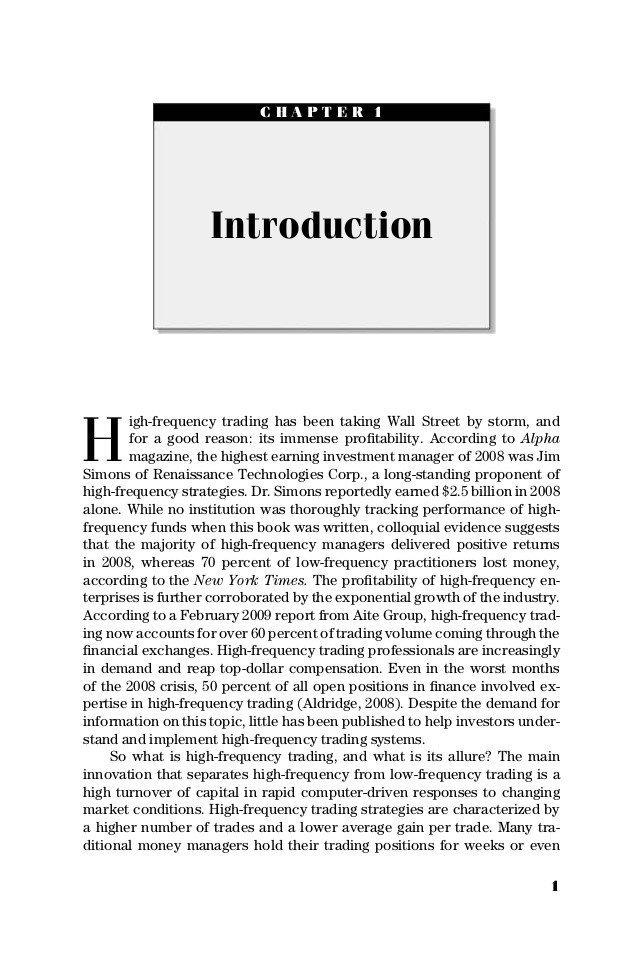The Use of Dynamically Optimised High Frequency Moving Average Strategies for Intraday Trading
Post on: 16 Март, 2015 No Comment

Page 1
Abstract—This paper is motivated by the aspect of uncertainty in
financial decision making, and how artificial intelligence and soft
computing, with its uncertainty reducing aspects can be used for
algorithmic trading applications that trade in high frequency.
This paper presents an optimized high frequency trading system that
has been combined with various moving averages to produce a hybrid
system that outperforms trading systems that rely solely on moving
INTRODUCTION
S computational power and data base capacities increase,
there will always be a parallel increase in the availability
of more data and information for trading systems to process.
High-frequency trading, despite being a new area, has proved
to be a ripe field for future implementation of trading systems
that can make use of this type of data and develop high
frequency trading strategies. The fundamental problem that
this thesis aspires to solve is to improve algorithmic trading
systems by taking a common sense based approach reflected
by fuzzy logic a decision making mechanism. Therefore, the
decisions taken by an algorithmic trading system should be
significant rather than just precise. When analysing the
problem from this perspective, it appears that fuzzy logic, as a
reasoning mechanism, is an obvious choice. However, fuzzy
logic on its own is never sufficient. Fuzzy logic can provide
very good results when used in designing trading systems, yet
using a hybrid fuzzy system would provide a much better
optimised trading system. Various artificial intelligence and
signal processing mechanisms will have to be incorporated in
the trading algorithms implemented to yield very good results.
The used application will The second application to be utilised
will be an Adaptive Neuro Fuzzy Inference System (ANFIS)
for high-frequency trading.
Dr. Abdalla Kablan is a lecturer and researcher at the Department of
Banking and Finance in the Faculty of Economics, Management, and
Accounting. University of Malta. Abdalla.Kablan@um.edu.mt
Professor Joseph Falzon is the Head of the Department of Banking and
Finance and the Dean of the Faculty Economics, Management, and
Accounting at the University of Malta. Joseph.falzon@um.edu.mt
This is an expert system that combines fuzzy reasoning with
the pattern recognition capability of neural networks. A new
event based volatilitymodel will counter unnecessary input in
the training phase and will therefore be proposed. The
Intraday Seasonality Observation Model is greatly enhanced
by taking factors such as the volatility and scaling laws of
financial time series into account. Excess data is thus removed
as this enhanced model makes it possible to observe specific
events and seasonalities in the data. The overall performance
of the Adaptive Neuro Fuzzy Inference System has been
greatly improved due to the more accurate input/data provided
by the new event based volatility model.
This paper extends on the concept of ANFIS that has been
introduced in [1,5] to optimise moving average strategies that
are very widely used in the industry. In this paper, ANFIS is
utilised to learn from the input of high frequency data and
moving averages applied on them to perform predictions on
the next market movement.
Due to the random nature of financial times series, the
prediction and forecast is extremely complicated, the
predictability/accurate forecast of most financial time series
such as stock prices or indices is a highly contentious issue as
the efficient market hypothesis declares that the current price
takes into account/uses/makes use of/contains all available
market information/data. [14]. Moreover, a filtering process
should be applied in order to separate the substantial noise
created by/caused by financial time series from the signal [3].
Furthermore, the practice of performing calculations in real-
world scenarios for the standard deviation in fixed time,
employed by traditional volatility models, has revealed major
drawbacks [11]. Measuring volatility should be done from an
event-based perspective by analyzing observations made after
the event. In addition, making the right decisions having
analyzed all of the inputs from other blocks is key to
producing an accurate system [6,7]. Artificial intelligence and
soft computing can provide a major solution to the above.
ANFIS combines two important aspects of artificial
intelligence. Neuro-fuzzy systems successfully combine the
human-like reasoning process of fuzzy logic with the ability of
neural networking to identify data patterns [16,1]. This














